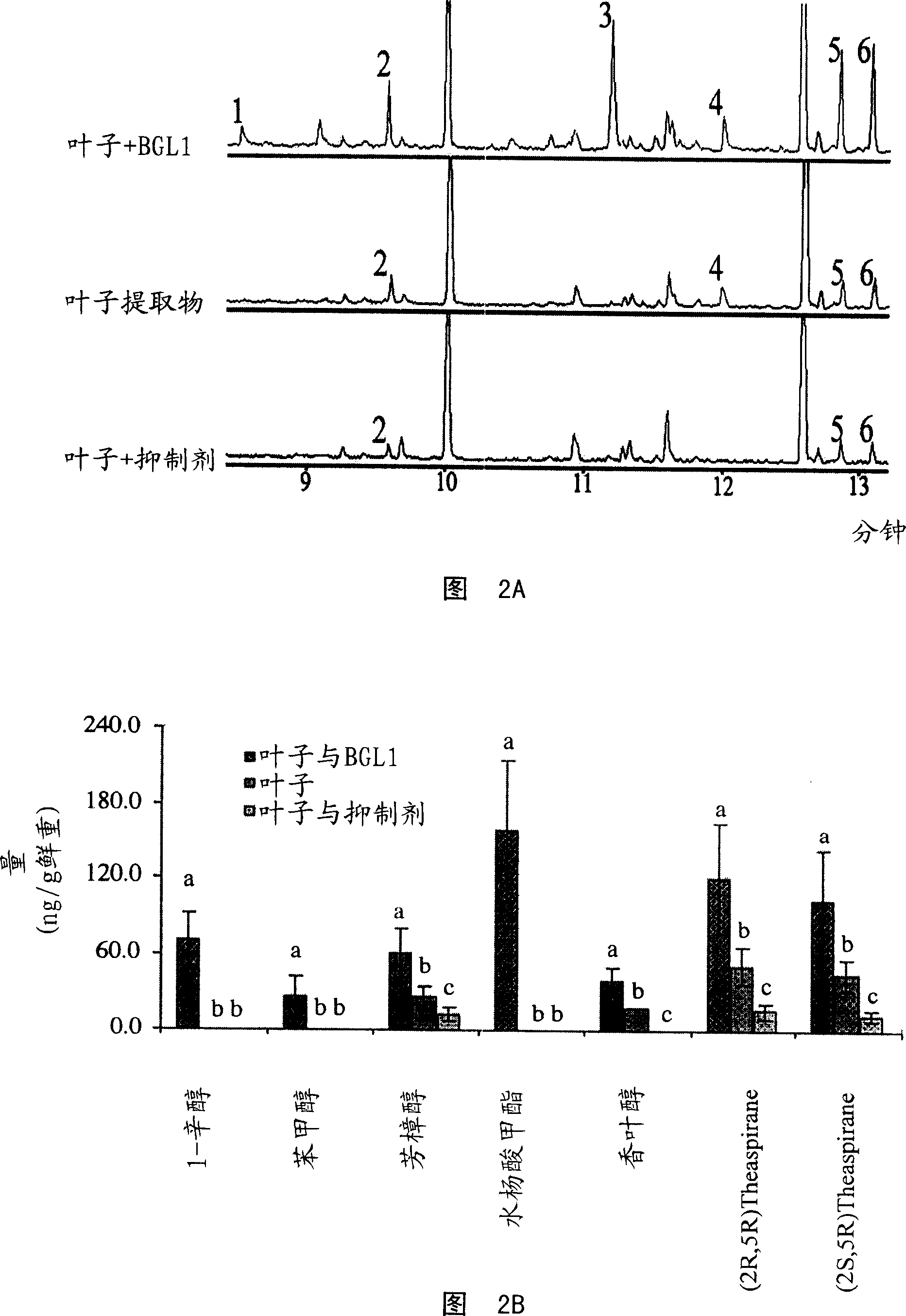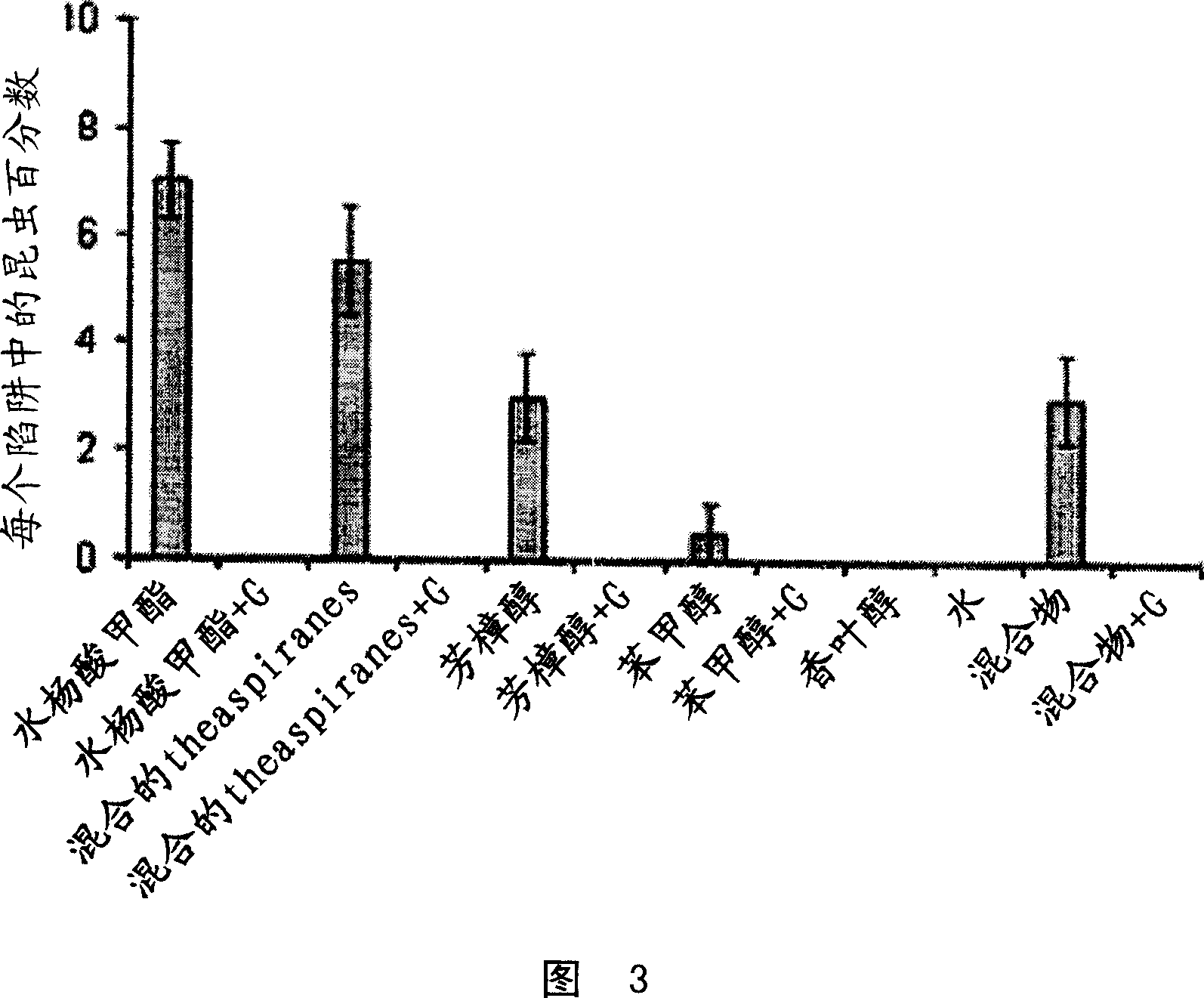Agents for control of codling moth in fruit orchards
A codling moth, orchard technology, applied in the direction of application, biocide, animal repellent, etc., can solve the problem that geraniol codling moth repellent is not described
- Summary
- Abstract
- Description
- Claims
- Application Information
AI Technical Summary
Problems solved by technology
Method used
Image
Examples
Embodiment 1
[0056] Example 1. Effect of β-Glucosidase Activity on the Attraction / Repulsion of Apple Leaf Extracts to Codling Moth Adults
[0057] Quantitative β-glucosidase activity assays using p-nitrophenyl β-D-glucopyranoside (pNPG) as substrate confirmed the residual activity of endogenous β-glucosidase in apple leaf extracts (0.24 unit g -1 fresh weight.min -1 ). Treatment with glucoimidazole (Heightman and Vasella, 1999) resulted in undetectable levels of β-glucosidase activity in leaf extracts.
[0058] Traps containing apple leaf extract and 2 μM glucoimidazole captured significantly more adult codling moths than traps containing leaf extract, leaf extract-treated BGL1, or water. Furthermore, significantly more insects were captured around the leaf plus inhibitor trap than any other trap (Figure 1). These fairly consistent results suggest that aglycones released by β-glucosidase activity have a repellent effect on codling moth insects. Furthermore, the complete inhibition of ...
Embodiment 2
[0060] Example 2. GC-MS Analysis of Apple Leaf Extracts Treated with BGL1 or β-Glucosidase Inhibitors
[0061] Headspace volatiles from leaf extracts treated with BGL1, β-glucosidase inhibitors, or not treated with SPME fibers were collected and analyzed by GC-MS. The detected volatiles are identified and quantified by comparing their mass spectra and retention indices to authentic synthetic standards. 1-octanol (CV, coefficient of variation, 32.6%), linalool (28.6%), geraniol ( 22.4%), benzyl alcohol (32.1%), methyl salicylate (41.9%), (2R,5R)-theaspirane (38.7%) and (2S,5R)-theaspirane (32.4%) levels significantly increased (Fig. 2), indicating that these compounds are mainly present in apple tree leaves as glycosides.
[0062] A. niger BGL1 released significantly more aglycone from leaf extracts compared to leaf extracts in the absence of exogenous β-glucosidase or β-glucosidase inhibitors. This could reflect a difference in substrate specificity between A. niger BGL1 an...
Embodiment 3
[0067] Example 3. Attractive / Repellent Effects of Beta-Glucosidase Enhancing Compounds on Codling Moth Insects
[0068] In cage bioassays, traps with the respective compounds at concentrations detected in leaf extracts were paired with control traps containing only water and ethanol. The attractiveness of the compounds to adults followed a descending order: methyl salicylate and a mixture of the two theaspirane isomers, followed by linalool, then benzyl alcohol. All these compounds were more attractive than water as a blank (Fig. 3). Interestingly, traps with a mixture of all these compounds did not catch the most insects. To our knowledge, this is the first report of theaspirane isomers as attractants for codling moths. In addition to the widely accepted technique of insect mating disruption (Calkins and Faust, 2003), these compounds can be used as baits in mass captures of adults.
[0069] Has 70ng ml -1 The 1-octanol traps did not capture any insects, and adding the sam...
PUM
 Login to View More
Login to View More Abstract
Description
Claims
Application Information
 Login to View More
Login to View More - R&D
- Intellectual Property
- Life Sciences
- Materials
- Tech Scout
- Unparalleled Data Quality
- Higher Quality Content
- 60% Fewer Hallucinations
Browse by: Latest US Patents, China's latest patents, Technical Efficacy Thesaurus, Application Domain, Technology Topic, Popular Technical Reports.
© 2025 PatSnap. All rights reserved.Legal|Privacy policy|Modern Slavery Act Transparency Statement|Sitemap|About US| Contact US: help@patsnap.com



